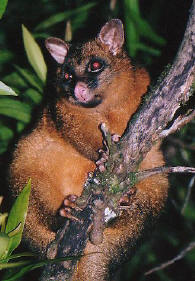Coppery Brushtail Possum

Photo: Courtesy of Damon Ramsey
BSc.(Zool) Biologist Guide
Coppery Brushtail Possum: (Trichosurus vulpecular johnstonii) It is a marsupialDark brown coat above, and a light brown underside.Long oval earsTail is bushy to its tip with a short terminal naked area beneath.Even though they are common, their conservation is no less important.Habitat: - Being a nocturnal animal, it spends its days in a den in a hollow dead branch, tree trunk, fallen log or even at times on the ground.
- It is an arboreal animal, climbing trees with its sharp claws
- It travels from tree to tree across the rainforest floor
Diet: - The brushtail possum eats a variety of leaves, especially eucalyptus, supplemented with fruits, buds, bark and meat is eaten if offered.
Social Behaviour: - The possum communicates by sound and scent.
- Deep guttural coughs and sharp hisses are used during the breeding season.
- Glands under the chin, on the chest and near the anus mark territories of particular individuals.
Viewing Opportunities: - Best viewing opportunity is the Crater National Park Picnic Area after dark.
- Can also be viewed, with a spotlight, on the Malanda falls Environmental Park walking paths.
- Their growls can be heard of a night at Chambers Wildlife Rainforest Lodges and they
occasionally visit the lodges verandah railings. - The Curtain Fig Tree and along the roadway on Thomas Road.
Brushtail Possums around housing: - They will take advantage of broken tiles, loose sheets of iron or unfinished work in cities and towns to shelter in ceilings or between floors. To help with this problem, the Queensland National Parks and Wildlife Service receives hundreds of calls each year.
- In Queensland, the brushtail possum is protected, and a permit is needed before one can be trapped and moved.
- Sometimes a noise in the ceiling may actually be a rat, not a possum. Brushtail possums can be easily identified by their black bushy tails, large erect ears, and silver-grey coat. They are about the same size as a cat.
- The noises the possums make are different to those of a rat. A rat makes a scratching and chewing noise, whereas a possum makes a loud, heavy thumping sound when it walks on flat surfaces.
- Removing a possum simply does not work. This is as another possum from nearby will take its place. Also, animals that have been removed generally face a slow death as the release area is unsuitable or it is already occupied by another brushtail (which will defend its territory vigorously). The released brushtail will usually be the possum that dies if there is any conflict.
- For traps, sliced apple with a dash of vanilla as bait can be effective.
- After blocking a possum’s entry to a house, a wooden box or hollow log can be hung in a nearby tree to provide the animal with a new nest.
Additional Information: This possum can be found, in one form or another throughout most of Australia. It has benefited from human settlement, however, and it appears to be much more common in urban areas than in the woodlands it originally inhabited, with higher densities. In the cities, the brushtails have adapted to an urban lifestyle and feed off practically anything, picking through garbage bins and taking food off people. The 'Brushtails' are probably the most vocal of the generally quiet marsupials, and their large fox-like ears reflect how important vocal communication is. Its growls, chattering, clicks and screams are sometimes quite eerie and scary in the bush at night. The musky smelling scent produced from the glands means 'brushies' tend have a particular odour. It’s tail is quite prehensile, and they can hang upside down off a branch by just their tail.
Script: Courtesy of Damon Ramsey BSc.(Zool) Biologist Guide |
